Parameter Optimization of Hybrid-Tandem Gas Metal Arc Welding Using Analysis of Variance-Based Gaussian Process Regression
Abstract
1. Introduction
2. Hybrid-Tandem GMAW PROCESS
2.1. Experimental Set-Up
2.2. Effects of Process Parameters on the Penetration Shape
3. Parameter Optimization Using the ANOVA-GPR
3.1. ANOVA
3.2. GPR Modeling
3.3. Optimization Using the ANOVA-GPR
4. Conclusions
- A novel hybrid-tandem GMAW process which adds the filler-wire with opposite polarity needs to consider numerous process parameters and the relation between parameters causing strong nonlinearity, compared to the conventional tandem process. To accurately present this nonlinearity and find the significant process parameters among many parameters, the ANOVA-GPR method was implemented.
- The uncertainty of the hybrid-tandem GMAW is increased by the use of the additional filler-wire on the welding process. By adopting the ANOVA-GPR approach, we selected three major welding process parameters among several parameters related to this uncertainty and performed optimization successfully to improve the welding quality. In order to optimize the process, ISO-5817, which guides performance parameters, was used to define the cost function.
- This approach enables a high welding speed of 1.9 m/min, which is difficult to achieve in the hybrid-tandem GMAW process. The proposed approach can be applied to another manufacturing processes that are difficult to model due to complex phenomena, and ultimately can improve the system performance.
Author Contributions
Funding
Conflicts of Interest
Nomenclature
| GMAW | Gas Metal Arc Welding |
| GPR | Gaussian Process Regression |
| IWD | Inter-Wire Distance |
| MAG | Metal Active Gas |
| GA | Genetic Algorithm |
| RSM | Response Surface Methodology |
| BPNN | Back Propagation Neural Network |
| HAZ | Heat-Affected Zone |
| PSO | Particle Swarm Optimization |
| BPNN-PSO | Back Propagation Neural Network-Particle Swarm Optimization |
| GTAW | Gas Tungsten Arc Welding |
| ANN | Artificial Neural Network |
| UTS | Ultimate Tensile Strength |
| FS | Friction Stir |
| WAAM | Wire Arc Additive Manufacturing |
| ANOVA | Analysis of Variance |
| ANOVA-GPR | Analysis of Variance-based Gaussian Process Regression |
| CTWD | Contact Tip to Work Distance |
| PBR | Penetration Beyond the Root |
| Pv | Vertical Penetration |
| Ph | Horizontal Penetration |
| Parea | Penetration area |
| Lv | Vertical Leg length |
| Lh | Horizontal Leg length |
| C | Convexity |
| CL | Leading Current |
| VL | Leading Voltage |
| CT | Trailing Current |
| VT | Trailing Voltage |
| CF | Filler-wire Current |
| DOE | Design of the Experiment |
| DOF | Degree of Freedom |
| ARD | Automatic Relevance Determination |
| SQP | Sequential Quadratic Programming |
| STD | Standard Deviation |
References
- Kik, T.; Górka, J. Numerical simulations of laser and hybrid S700MC T-joint welding. Materials 2019, 12, 516. [Google Scholar] [CrossRef] [PubMed]
- Skowrόnska, B.; Chmielewski, T.; Golański, D.; Szulc, J. Weldability of S700MC steel welded with the hybrid plasma+ MAG method. Manuf. Rev. 2020, 7, 4. [Google Scholar] [CrossRef]
- Arora, H.; Kumar, V.; Prakash, C.; Pimenov, D.; Singh, M.; Vasudev, H.; Singh, V. Analysis of sensitization in austenitic stainless steel-welded joint. In Advances in Metrology and Measurement of Engineering Surfaces; Prakash, C., Krolczyk, G., Singh, S., Pramanik, A., Eds.; Springer: Singapore, 2021; pp. 13–23. [Google Scholar] [CrossRef]
- Arita, H.; Morimoto, T.; Nagaoka, S.; Nakano, T. Development of advanced 3-electrode MAG high-speed horizontal fillet welding process. Weld World. 2009, 53, 35–43. [Google Scholar] [CrossRef]
- Yokota, Y.; Shimizu, H.; Nagaoka, S.; Ito, K.; Arita, H. Development and application of the 3-electrode MAG high-speed horizontal fillet welding process. Weld World. 2012, 56, 43–47. [Google Scholar] [CrossRef]
- Xiang, T.; Li, H.; Gao, Y.; Zhao, S.; Lou, L.; Wang, H. Effects of pulse phase difference on metal transfer process and weld formation in the integrated circular triple-electrode GMAW. Int. J. Adv. Manuf. Technol. 2019, 102, 857–866. [Google Scholar] [CrossRef]
- Kim, D.; Rhee, S.; Park, H. Modelling and optimization of a GMA welding process by genetic algorithm and response surface methodology. Int. J. Prod. Res. 2002, 40, 1699–1711. [Google Scholar] [CrossRef]
- Moghaddam, M.A.; Golmezergi, R.; Kolahan, F. Multi-variable measurements and optimization of GMAW parameters for API-X42 steel alloy using a hybrid BPNN–PSO approach. Measurement 2016, 92, 279–287. [Google Scholar] [CrossRef]
- do Valle Tomaz, I.; Colaço, F.H.G.; Sarfraz, S.; Pimenov, D.Y.; Gupta, M.K.; Pintaude, G. Investigations on quality characteristics in gas tungsten arc welding process using artificial neural network integrated with genetic algorithm. Int. J. Adv. Manuf. Technol. 2021, 113, 3569–3583. [Google Scholar] [CrossRef]
- Rasmussen, C.E.; Williams, C.K.I. Gaussian Processes for Machine Learning (Adaptive Computation and Machine Learning); The MIT Press: Cambridge, MA, USA, 2005. [Google Scholar]
- Dong, H.; Cong, M.; Liu, Y.; Zhang, Y.; Chen, H. Predicting characteristic performance for arc welding process. In Proceedings of the 2016 IEEE International Conference on Cyber Technology in Automation, Control, and Intelligent Systems (CYBER), Chengdu, China, 19–22 June 2016; pp. 7–12. [Google Scholar] [CrossRef]
- Verma, S.; Gupta, M.; Misra, J.P. Performance evaluation of friction stir welding using machine learning approaches. MethodsX 2018, 5, 1048–1058. [Google Scholar] [CrossRef] [PubMed]
- Tapia, G.; Elwany, A.; Sang, H. Prediction of porosity in metal-based additive manufacturing using spatial Gaussian process models. Addit. Manuf. 2016, 12, 282–290. [Google Scholar] [CrossRef]
- Lee, S.H. Optimization of cold metal transfer-based wire arc additive manufacturing processes using gaussian process regression. Metals 2020, 10, 461. [Google Scholar] [CrossRef]
- Lee, D.Y.; Leifsson, L.; Kim, J.Y.; Lee, S.H. Optimisation of hybrid tandem metal active gas welding using Gaussian process regression. Sci. Technol. Weld. Join. 2020, 25, 208–217. [Google Scholar] [CrossRef]
- Tripathy, R.; Bilionis, I.; Gonzalez, M. Gaussian processes with built-in dimensionality reduction: Applications to high-dimensional uncertainty propagation. J. Comput. Phys. 2016, 321, 191–223. [Google Scholar] [CrossRef]
- Chen, C.; Liao, Q. ANOVA Gaussian process modeling for high-dimensional stochastic computational models. J. Comput. Phys. 2020, 416, 109519. [Google Scholar] [CrossRef]
- Çolak, Z.; Ayan, Y.; Kahraman, N. Weld morphology and mechanical performance of marine structural steel welded underwater in a real marine environment. Int. J. Adv. Manuf. Technol. 2020, 109, 491–501. [Google Scholar] [CrossRef]
- Crupi, V.; Epasto, G.; Guglielmino, E.; Marinò, A. Influence of Weld-Porosity Defects on Fatigue Strength of AH36 Butt Joints Used in Ship Structures. Metals 2021, 11, 444. [Google Scholar] [CrossRef]
- Pazooki, A.; Hermans, M.; Richardson, I. Control of welding distortion during gas metal arc welding of AH36 plates by stress engineering. Int. J. Adv. Manuf. Technol. 2017, 88, 1439–1457. [Google Scholar] [CrossRef][Green Version]
- Elman, H.C.; Liao, Q. Reduced basis collocation methods for partial differential equations with random coefficients. SIAM/ASA J. Uncertain. Quantif. 2013, 1, 192–217. [Google Scholar] [CrossRef][Green Version]
- Gallagher, E.J. P < 0.05: Threshold for decerebrate genuflection. Acad. Emerg. Med. 1999, 6, 1084–1087. [Google Scholar] [CrossRef] [PubMed]
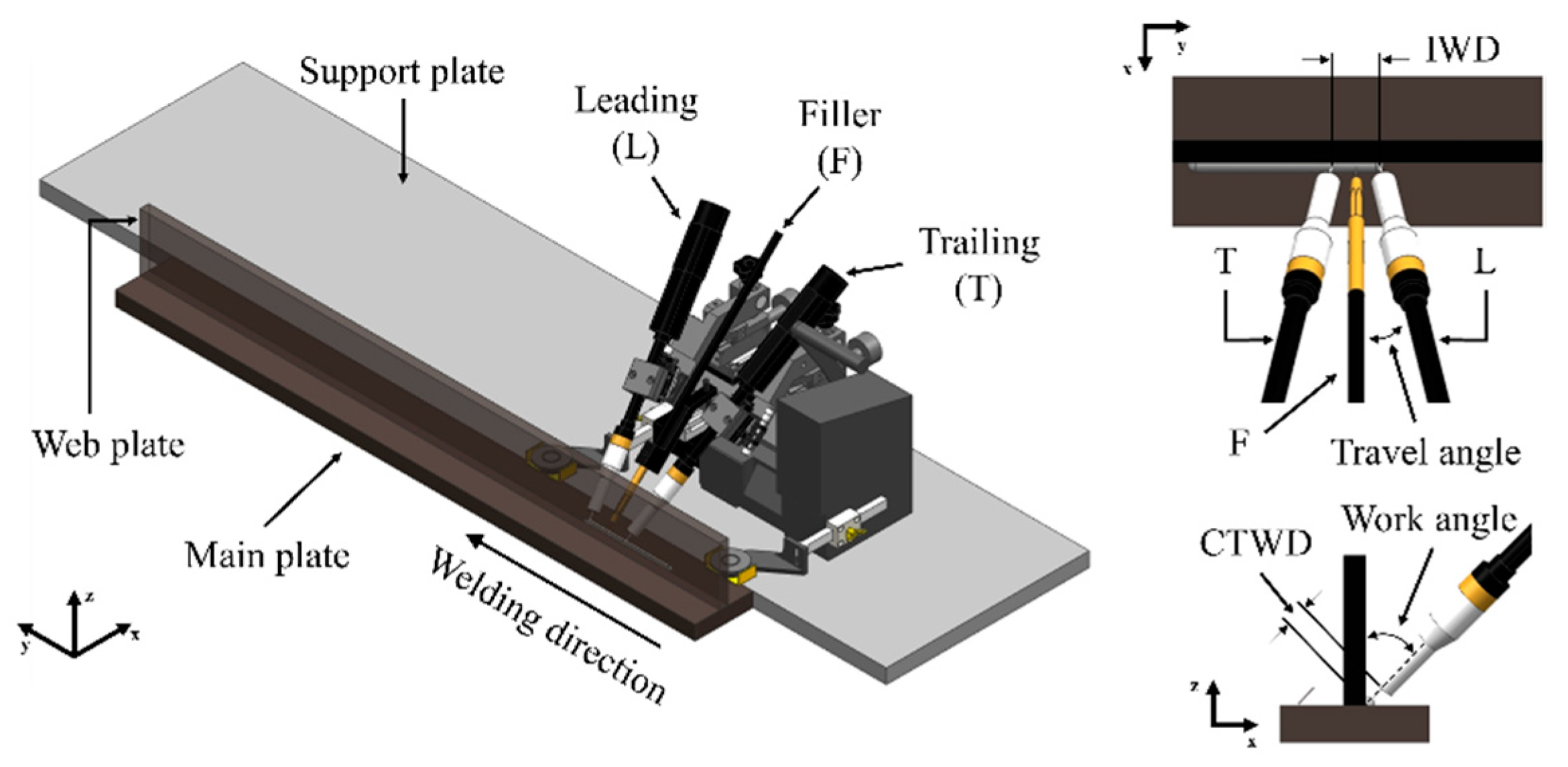
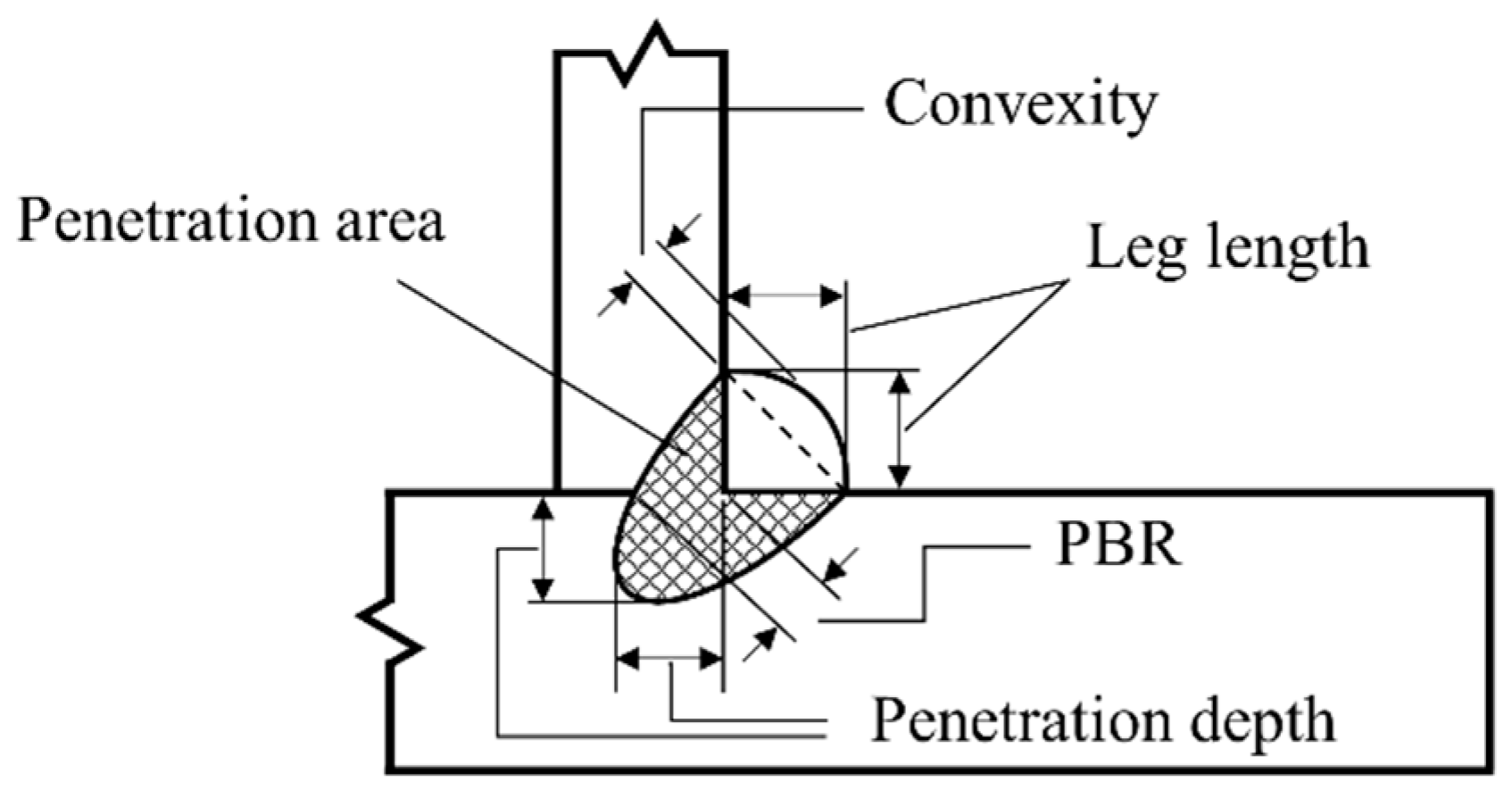

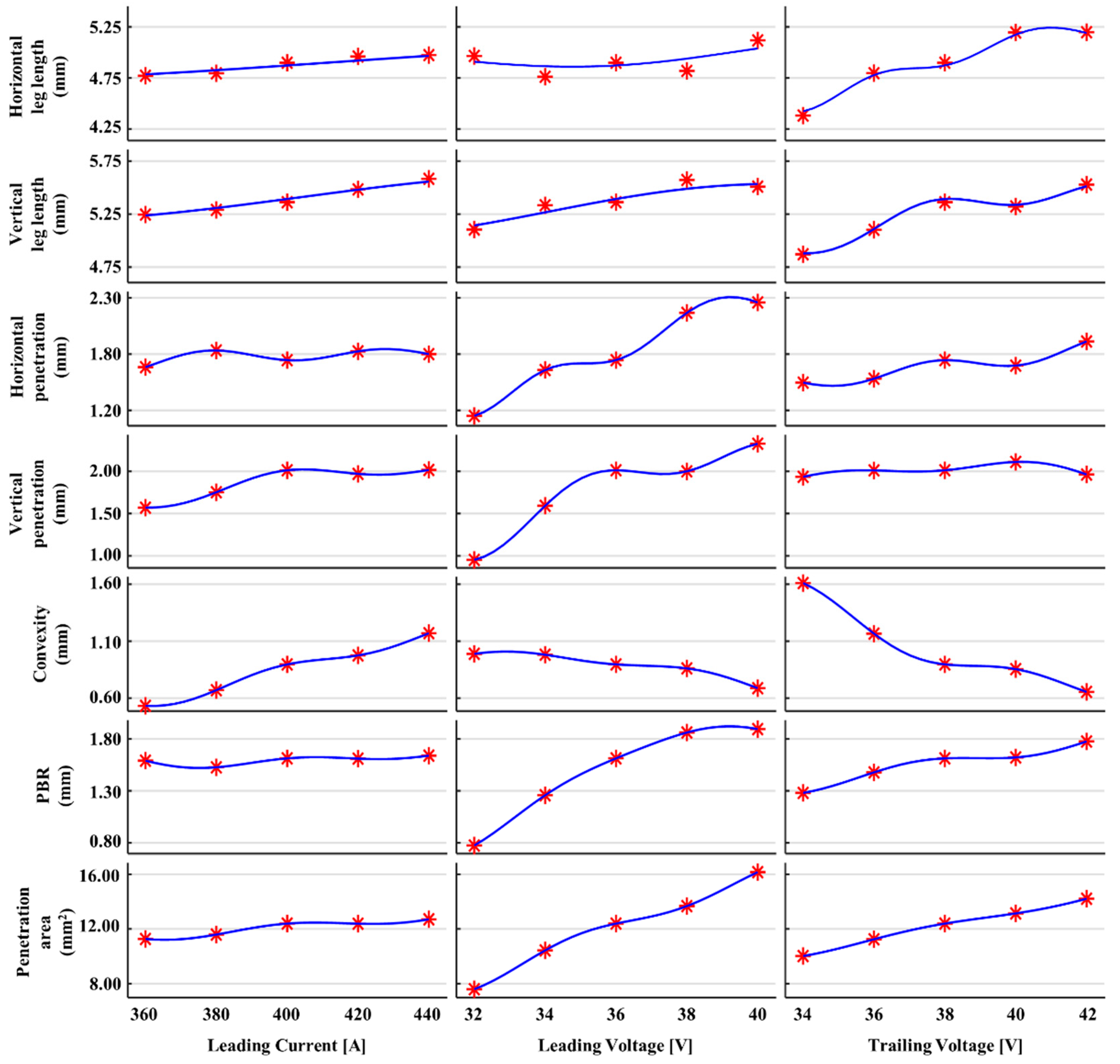
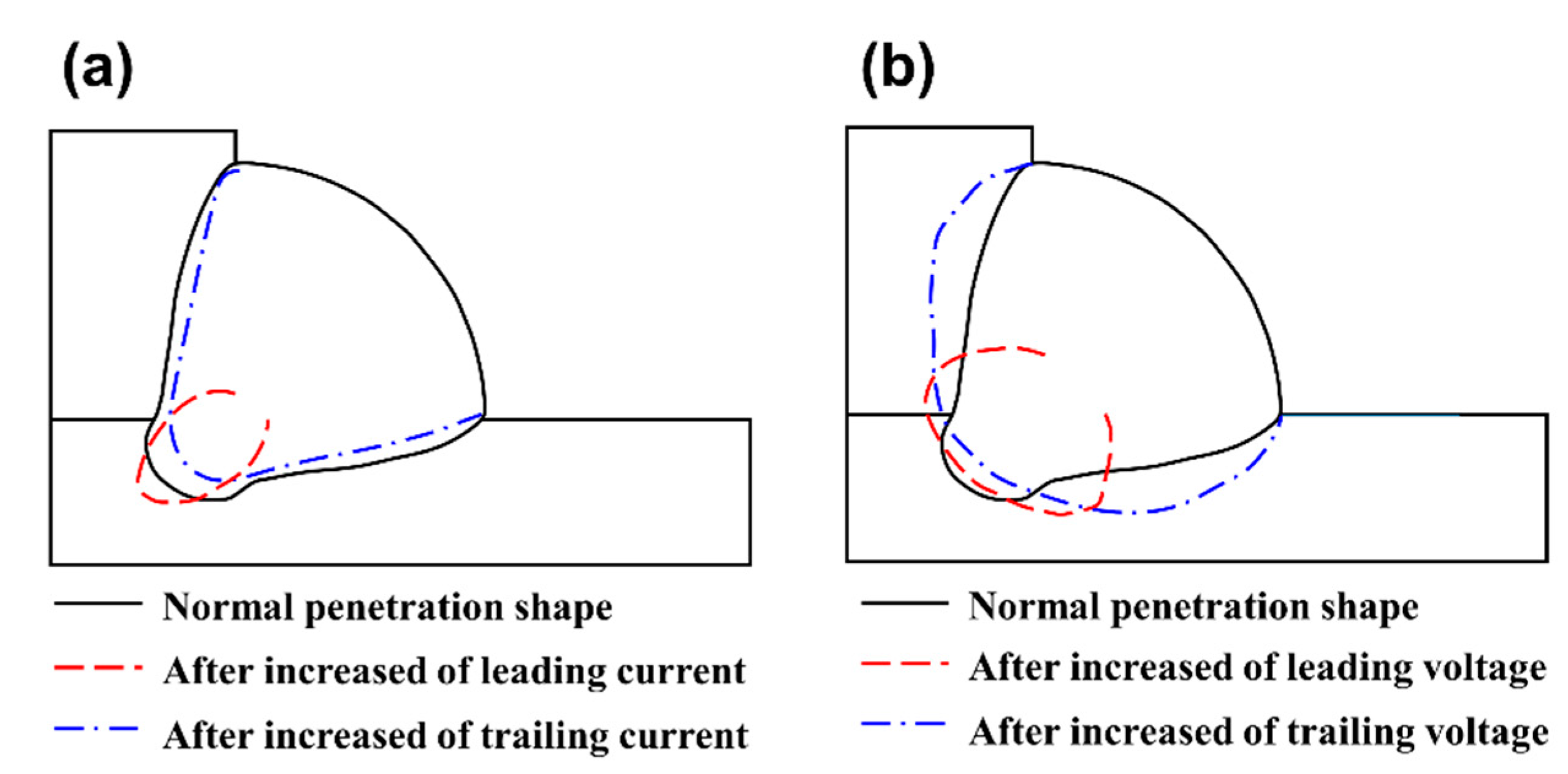
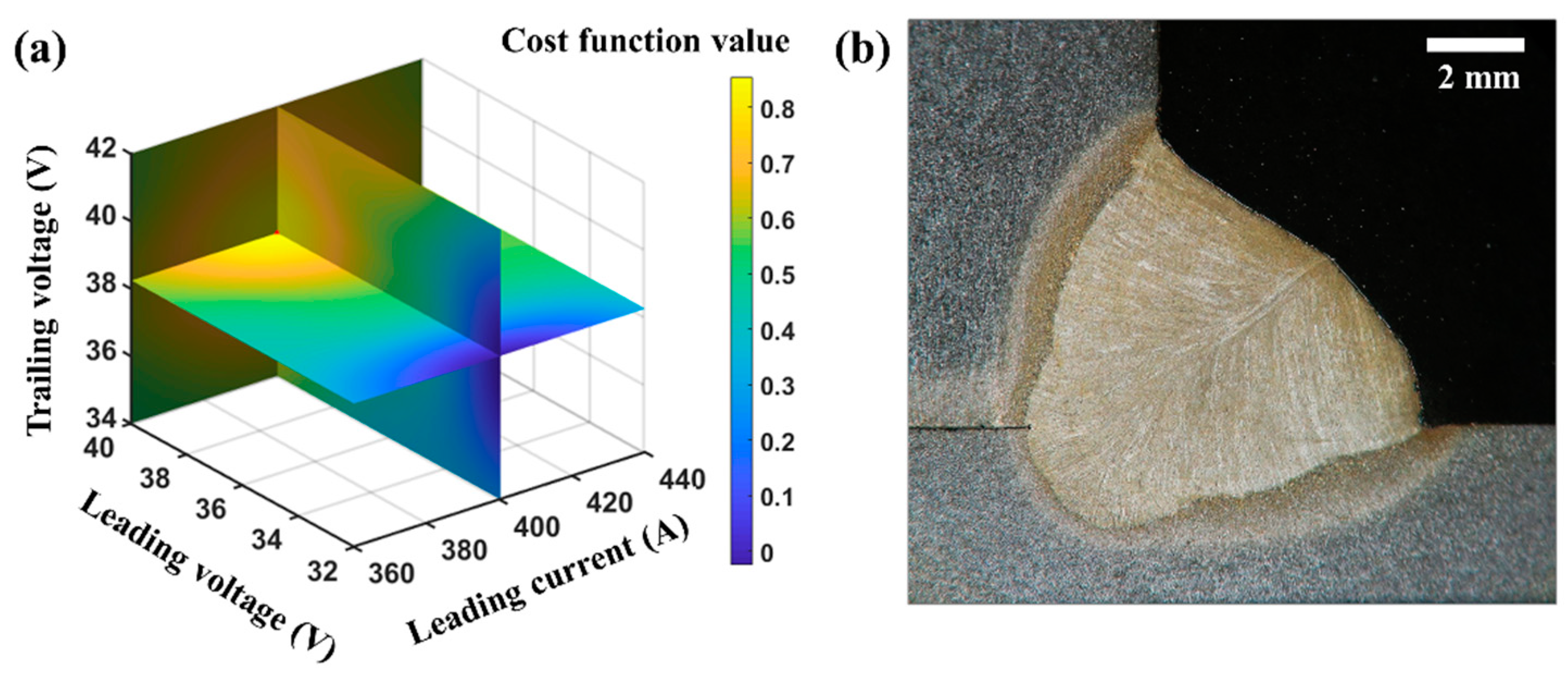
| Materials | Element (wt %) | |||||||||
|---|---|---|---|---|---|---|---|---|---|---|
| C | Si | Mn | P | S | Cu | Ni | Cr | Mo | V | |
| AH36 | 0.150 | 0.360 | 1.410 | 0.013 | 0.007 | 0.010 | 0.010 | 0.030 | 0.001 | 0.001 |
| E71T-1C | 0.032 | 0.500 | 1.250 | 0.050 | 0.000 | 0.012 | 0.020 | 0.030 | 0.007 | 0.019 |
| ER70S-3 | 0.070 | 0.680 | 1.170 | 0.012 | 0.011 | 0.170 | 0.010 | 0.040 | 0.000 | 0.003 |
| Parameter | Level | Pv (STD) | Ph (STD) | PBR (STD) | Parea (STD) | Lv (STD) | Lh (STD) | C (STD) |
|---|---|---|---|---|---|---|---|---|
| CL (A) | 360 | 1.57 | 1.68 | 1.59 | 11.27 | 5.25 | 4.77 | 0.53 |
| (0.13) | (0.06) | (0.07) | (0.22) | (0.10) | (0.08) | (0.05) | ||
| 380 | 1.75 | 1.83 | 1.53 | 11.59 | 5.29 | 4.79 | 0.67 | |
| (0.08) | (0.10) | (0.12) | (0.30) | (0.11) | (0.10) | (0.05) | ||
| 400 | 2.01 | 1.75 | 1.61 | 12.39 | 5.36 | 4.90 | 0.90 | |
| (0.08) | (0.09) | (0.10) | (0.57) | (0.13) | (0.13) | (0.05) | ||
| 420 | 1.97 | 1.82 | 1.61 | 12.38 | 5.48 | 4.96 | 0.96 | |
| (0.22) | (0.12) | (0.12) | (0.56) | (0.09) | (0.16) | (0.06) | ||
| 440 | 2.02 | 1.80 | 1.64 | 12.71 | 5.58 | 4.97 | 1.17 | |
| (0.09) | (0.09) | (0.10) | (0.31) | (0.10) | (0.06) | (0.13) | ||
| VL (V) | 32 | 0.95 | 1.25 | 0.77 | 7.59 | 5.11 | 4.96 | 0.99 |
| (0.06) | (0.06) | (0.06) | (0.26) | (0.12) | (0.09) | (0.09) | ||
| 34 | 1.59 | 1.66 | 1.26 | 10.43 | 5.33 | 4.76 | 0.98 | |
| (0.12) | (0.08) | (0.10) | (0.12) | (0.06) | (0.19) | (0.08) | ||
| 36 | 2.01 | 1.75 | 1.61 | 12.39 | 5.36 | 4.90 | 0.90 | |
| (0.08) | (0.09) | (0.10) | (0.57) | (0.13) | (0.13) | (0.05) | ||
| 38 | 2.00 | 2.17 | 1.86 | 13.67 | 5.57 | 4.82 | 0.86 | |
| (0.23) | (0.09) | (0.11) | (0.69) | (0.14) | (0.16) | (0.09) | ||
| 40 | 2.33 | 2.26 | 1.89 | 16.15 | 5.51 | 5.12 | 0.69 | |
| (0.05) | (0.08) | (0.12) | (0.78) | (0.08) | (0.17) | (0.08) | ||
| CT (A) | 320 | 2.22 | 1.61 | 1.54 | 11.77 | 5.37 | 5.22 | 0.50 |
| (0.13) | (0.04) | (0.05) | (0.26) | (0.11) | (0.06) | (0.04) | ||
| 340 | 2.10 | 1.65 | 1.58 | 12.38 | 5.38 | 5.15 | 0.76 | |
| (0.08) | (0.07) | (0.05) | (0.34) | (0.07) | (0.11) | (0.04) | ||
| 360 | 2.01 | 1.75 | 1.61 | 12.39 | 5.36 | 4.90 | 0.90 | |
| (0.08) | (0.09) | (0.10) | (0.57) | (0.13) | (0.13) | (0.05) | ||
| 380 | 1.95 | 1.86 | 1.61 | 12.52 | 5.46 | 4.73 | 1.26 | |
| (0.22) | (0.07) | (0.09) | (0.32) | (0.11) | (0.13) | (0.08) | ||
| 400 | 1.99 | 1.98 | 1.63 | 12.55 | 5.49 | 4.33 | 1.62 | |
| (0.09) | (0.11) | (0.09) | (0.59) | (0.13) | (0.14) | (0.14) | ||
| VT (V) | 34 | 1.94 | 1.55 | 1.28 | 10.02 | 4.57 | 4.38 | 1.61 |
| (0.14) | (0.04) | (0.08) | (0.42) | (0.11) | (0.20) | (0.07) | ||
| 36 | 2.01 | 1.58 | 1.48 | 11.24 | 5.10 | 4.80 | 1.17 | |
| (0.03) | (0.10) | (0.13) | (0.49) | (0.12) | (0.12) | (0.04) | ||
| 38 | 2.01 | 1.75 | 1.61 | 12.39 | 5.36 | 4.90 | 0.90 | |
| (0.08) | (0.09) | (0.10) | (0.57) | (0.13) | (0.13) | (0.05) | ||
| 40 | 2.11 | 1.70 | 1.62 | 13.13 | 5.32 | 5.20 | 0.86 | |
| (0.08) | (0.05) | (0.06) | (0.36) | (0.06) | (0.13) | (0.07) | ||
| 42 | 1.96 | 1.91 | 1.78 | 14.21 | 5.53 | 5.20 | 0.66 | |
| (0.11) | (0.09) | (0.08) | (0.31) | (0.13) | (0.07) | (0.03) | ||
| CF (A) | 60 | 1.93 | 1.91 | 1.65 | 12.72 | 5.37 | 4.68 | 0.82 |
| (0.24) | (0.16) | (0.10) | (0.46) | (0.15) | (0.24) | (0.08) | ||
| 80 | 2.17 | 1.57 | 1.61 | 12.46 | 5.31 | 4.96 | 0.87 | |
| (0.20) | (0.18) | (0.19) | (0.21) | (0.09) | (0.23) | (0.05) | ||
| 100 | 2.01 | 1.75 | 1.61 | 12.39 | 5.36 | 4.90 | 0.90 | |
| (0.08) | (0.09) | (0.10) | (0.57) | (0.13) | (0.13) | (0.05) | ||
| 120 | 2.13 | 1.68 | 1.61 | 12.35 | 5.46 | 4.95 | 0.94 | |
| (0.06) | (0.07) | (0.05) | (0.48) | (0.08) | (0.09) | (0.05) | ||
| 140 | 1.86 | 1.76 | 1.60 | 12.31 | 5.44 | 4.88 | 0.97 | |
| (0.06) | (0.07) | (0.04) | (0.53) | (0.13) | (0.10) | (0.04) | ||
| IWD (mm) | 20.0 | 1.91 | 1.86 | 1.66 | 13.11 | 5.49 | 5.07 | 0.86 |
| (0.22) | (0.10) | (0.13) | (0.46) | (0.08) | (0.16) | (0.04) | ||
| 22.5 | 2.06 | 1.59 | 1.55 | 12.47 | 5.37 | 5.03 | 0.91 | |
| (0.08) | (0.08) | (0.08) | (0.53) | (0.08) | (0.11) | (0.06) | ||
| 25.0 | 2.01 | 1.75 | 1.61 | 12.39 | 5.36 | 4.90 | 0.90 | |
| (0.08) | (0.09) | (0.10) | (0.57) | (0.13) | (0.13) | (0.05) | ||
| 27.5 | 1.80 | 1.97 | 1.65 | 12.56 | 5.26 | 4.86 | 0.96 | |
| (0.24) | (0.17) | (0.10) | (0.34) | (0.14) | (0.16) | (0.08) | ||
| 30.0 | 1.99 | 1.71 | 1.55 | 11.51 | 5.16 | 4.78 | 1.00 | |
| (0.03) | (0.08) | (0.06) | (0.40) | (0.21) | (0.18) | (0.10) | ||
| Position | 1 | 2.67 | 1.66 | 0.78 | 13.04 | 4.77 | 5.25 | 1.08 |
| (0.10) | (0.13) | (0.08) | (0.43) | (0.19) | (0.11) | (0.05) | ||
| 2 | 2.40 | 1.7 | 1.29 | 12.92 | 5.17 | 5.15 | 0.78 | |
| (0.08) | (0.06) | (0.09) | (0.42) | (0.19) | (0.13) | (0.05) | ||
| 3 | 2.01 | 1.75 | 1.61 | 12.39 | 5.36 | 4.90 | 0.90 | |
| (0.08) | (0.09) | (0.10) | (0.57) | (0.13) | (0.13) | (0.05) | ||
| 4 | 1.43 | 2.07 | 1.82 | 11.73 | 5.67 | 4.82 | 0.89 | |
| (0.16) | (0.14) | (0.19) | (0.40) | (0.08) | (0.17) | (0.11) | ||
| 5 | 1.13 | 2.60 | 2.25 | 11.69 | 5.55 | 4.83 | 0.67 | |
| (0.05) | (0.06) | (0.10) | (0.26) | (0.04) | (0.09) | (0.06) |
| Parameter | DOF | Sum of Squares | Mean of Squares | F-Value | p-Value |
|---|---|---|---|---|---|
| CL | 4 | 1.7204 | 0.4301 | 2.96 | 0.020 |
| VL | 4 | 34.0253 | 8.5063 | 58.63 | 0.000 |
| CT | 4 | 0.2511 | 0.0628 | 0.43 | 0.785 |
| VT | 4 | 6.9363 | 1.7341 | 11.95 | 0.000 |
| CF | 4 | 0.1633 | 0.0408 | 0.28 | 0.890 |
| IWD | 4 | 0.7678 | 0.1920 | 1.32 | 0.262 |
| Position | 4 | 0.6279 | 0.1570 | 1.08 | 0.366 |
| Error | 235 | 34.0972 | 0.1451 | - | - |
| Total | 263 | 77.2694 | - | - | - |
| Pv (mm) | Ph (mm) | PBR (mm) | Parea (mm) | Lv (mm) | Lh (mm) | C (mm) | |
|---|---|---|---|---|---|---|---|
| Experiment (STD) | 2.12 (0.06) | 2.49 (0.11) | 2.11 (0.15) | 16.51 (0.65) | 6.11 (0.07) | 5.20 (0.26) | 0.76 (0.11) |
| GPR | 2.32 | 2.25 | 1.89 | 16.19 | 5.53 | 5.05 | 0.69 |
Publisher’s Note: MDPI stays neutral with regard to jurisdictional claims in published maps and institutional affiliations. |
© 2021 by the authors. Licensee MDPI, Basel, Switzerland. This article is an open access article distributed under the terms and conditions of the Creative Commons Attribution (CC BY) license (https://creativecommons.org/licenses/by/4.0/).
Share and Cite
Kim, J.Y.; Lee, D.Y.; Lee, J.; Lee, S.H. Parameter Optimization of Hybrid-Tandem Gas Metal Arc Welding Using Analysis of Variance-Based Gaussian Process Regression. Metals 2021, 11, 1087. https://doi.org/10.3390/met11071087
Kim JY, Lee DY, Lee J, Lee SH. Parameter Optimization of Hybrid-Tandem Gas Metal Arc Welding Using Analysis of Variance-Based Gaussian Process Regression. Metals. 2021; 11(7):1087. https://doi.org/10.3390/met11071087
Chicago/Turabian StyleKim, Jin Young, Dae Young Lee, Jaeyoung Lee, and Seung Hwan Lee. 2021. "Parameter Optimization of Hybrid-Tandem Gas Metal Arc Welding Using Analysis of Variance-Based Gaussian Process Regression" Metals 11, no. 7: 1087. https://doi.org/10.3390/met11071087
APA StyleKim, J. Y., Lee, D. Y., Lee, J., & Lee, S. H. (2021). Parameter Optimization of Hybrid-Tandem Gas Metal Arc Welding Using Analysis of Variance-Based Gaussian Process Regression. Metals, 11(7), 1087. https://doi.org/10.3390/met11071087







